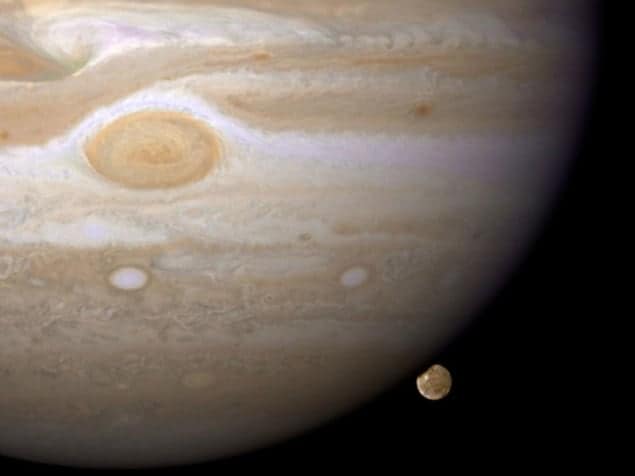
The European Space Agency (ESA) has announced that a mission to Jupiter has beaten two other candidates to be the agency’s pick for its first “large” class (L-class) mission. The €850m Jupiter Icy Moons Explorer (JUICE) is expected to launch in 2022 and will travel to Jupiter and its moons. The 19 members of ESA’s Science Programme Committee opted for the craft during a meeting today in Paris following a recommendation from the ESA executive last month. The mission is the first L-class probe as part of ESA’s Cosmic Vision 2015–2025 programme.
JUICE is expected to carry about 11 instruments, which are not included in the mission’s €850m price tag as they will be paid for by the member states that build them. Once launched in 2022, the mission will take eight years to reach Jupiter, where the craft will then test the conditions that may have led to the emergence of habitable environments. “JUICE is a very exciting mission, and it’s about time Europe did another big planetary exploration, so I am not surprised the ESA executive sees this as the obvious thing to do,” says astronomer Andy Lawrence from the University of Edinburgh in the UK.
The missions that have missed out are an X-ray observatory called the Advanced Telescope for High Energy Astrophysics (ATHENA) and the New Gravitational Wave Observatory (NGO). Both ATHENA and NGO are downgraded versions of the €3.8bn International X-ray Observatory (IXO) and €1.8bn Laser Interferometer Space Antenna (LISA), both of which had to be redesigned after the US pulled out because of budget constraints. LISA was designed to measure gravitational waves – tiny ripples in space–time that are an unobserved prediction of Einstein’s general theory of relativity and that are believed to occur whenever massive objects accelerate. IXO was planned for launch in 2021 to study black holes and the hot gas associated with galaxies and stars.
The JUICE mission is also the result of NASA pulling out of the Europa Jupiter System Mission (EJSM/Laplace) – a joint mission with ESA that would have involved sending two probes to Jupiter and its moons: NASA’s Jupiter Europa Orbiter (JEO) and ESA’s Jupiter Ganymede Orbiter (JGO). JUICE is now based on the design for JGO and will focus in particular on studying three of Jupiter’s moons: Ganymede, Callisto and Europa.
“[This decision has] everything to do with NASA, and is really just about money,” says Lawrence. “NASA pulled out of all three predecessor missions – LAPLACE, IXO and LISA – so we just don’t have enough money to carry out the old plan.”
A “scary” decision
The announcement last month that the ESA executive had opted for JUICE caused consternation within groups working on NGO and ATHENA. Indeed, the NGO team sent a letter to Alvaro Gimenez, ESA’s director of science, complaining about how the process was handled, while the ATHENA team started a petition – created by Kirpal Nandra from the Max Planck Institute for Extraterrestrial Physics in Garching, Germany, along with 10 other astronomers – to save the mission.
“ATHENA offers a huge leap forward in capabilities with respect to current X-ray observatories and is at present the only possibility for a major astronomical observatory operating in the X-ray band a decade from now,” the petition authors write. The petition got the support of more than 1450 astronomers, and in addition to being sent to Gimenez was also passed on to representatives of the Science Programme Committee.
“ESA’s report to the Science Programme Committee contains no justification for the recommendation of JUICE,” Nandra told physicsworld.com. “The details of the decision-making process have been kept secret, so officially there is no information as to why we got the result we did.”
Lawrence says that ESA’s decision could damage European X-ray astronomy. “Astronomers will carry on doing X-ray related science,” he says. “But we will lose the technical and engineering skills, so we won’t be ready to build the next big mission when it finally comes. That is scary.”
That view is shared by Nandra, who says that the decision “could be a disaster, not just for X-ray astronomy, but the whole of astronomy and astrophysics”. He adds that there is now a “very real possibility” that there will be no operating X-ray observatory at all in the 2020s, as other national space agencies have nothing planned beyond the current decade.
It is likely, but not certain, that ESA will still launch a second L-class mission before the end of 2030, which will be a choice between ATHENA and NGO. “It’s really all about ATHENA versus NGO,” adds Lawrence.



